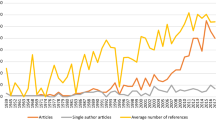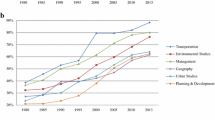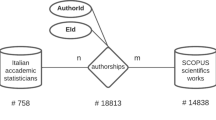Abstract
This paper introduces the use of co-nomination as a method to map research fields by directly accessing their knowledge networks organised around exchange relationships of intellectual influence. Co-nomination is a reputation-based approach combining snowball sampling and social network analysis. It compliments established bibliometric mapping methods by addressing some of their typical shortcomings in specific instances. Here we test co-nomination by mapping one such instance: the idiosyncratic field of CERN-based heavy flavour physics (HFP). HFP is a ‘hyper-authorship’ field where papers conventionally list thousands of authors alphabetically, masking individual intellectual contributions. We also undertook an illustrative author co-citation analysis (ACA) mapping of 2310 HFP articles published 2013–18 and identified using a simple keyword query. Both maps were presented to two HFP scientists for commentary upon structure and validity. Our results suggest co-nomination allows us to access individual-level intellectual influence and discern the experimental and theoretical HFP branches. Co-nomination is powerful in uncovering current and emerging research specialisms in HFP that might remain opaque to other methods. ACA, however, better captures HFP’s historical and intellectual foundations. We conclude by discussing possible future uses of co-nomination in science policy and research evaluation arrangements.

Source: Authors

Source: Authors

Sources: Web of Science; total N = 3482; Left: n = 1974; Right: n = 19; calculations by the authors

Source: Authors; Left: n = 538; Right: n = 12
Similar content being viewed by others
Notes
Here we necessarily disregard other layers to the notion of knowledge community we have been discussing, such as values, normative and social control aspects. These would require other, more qualitative and extensive methods to address.
Membership in the LHC experiments is institutional, not country based. Member organisations are obligated to make annual contributions towards operating costs and towards the costs of equipment upgrading. The required amount of the contribution changes depending on the number of scientific authors from that organisation in the experiment.
This pre-print culture seemingly emerged to bypass journal processing times. It is now so widespread in HEP that Gentil-Beccot et al. (2010) state journals have ‘lost their role as a means of scientific discourse’ in HEP and instead constitute merely a ‘repository’ and ‘independent accreditation’ for research (p. 354).
Physics analyses at CERN experiments are interpreted and reviewed within the collaboration before they are released publicly. Typically, small teams of scientists responsible for analysis of experimental data will draft and review an initial version of a publication before it is then also peer-reviewed by other physicists in the collaboration.
We recognise that networks sampled in this way are never complete, but they do provide insights about overall network structure and these networks can be quantitatively analysed. Co-nomination networks have robust degree centrality (Costenbader and Valente 2003) and represent core structural relations between members after a certain number of nomination rounds (Wejnert 2010). Co-nomination is also useful to study emic social groups with fuzzy boundaries, as self-identified by their members. Co-nomination has also been employed successfully to identify participants of the UK Technology Foresight Programme to identify expert networks around a variety of topics (Nedeva et al. 1996).
The resulting network of linkages is not dissimilar to an ACA network, in which author pairs are counted as semantically linked if cited together in an article. No systematic examination has yet been performed about the similarity of outcomes obtained through these different methods. An analysis by Giusti and Georghiou (1988) suggests co-nomination mapping yields similar results to those derived from citation-based scores, for fields where the two can be directly compared.
The number of workshop participants ranged from 80 to over 200. These workshops were held in Austria, France, India, Italy, the UK and the USA.
This implies around 20 weeks in total to deploy this approach (i.e. a minimum 4 weeks per round, which could be extended to allow for additional response time following the final reminder). Overall, we took six months to follow this approach because a holiday period also fell in the middle of our study.
Ten countries had ten or more responses, including China, India, France, the Netherlands, and Japan. The major country-level representation broadly corresponds with both volumes of HFP publications and accumulated citation scores, except for India. We estimate over-representation of survey respondents from India was a characteristic of our starter sample. The 2016 CKM workshop was held in Mumbai and was attended by local scientists. However we did not find an over-representation of Indian scientists amongst our nominees.
Using ACA to map the intellectual influence structure of HFP comes up against the collective authorship conventions and opaque individual contributions of experimental HFP. Research attempting this task so far had to gain access to exclusive data not publicly available and had to limit its scope either to one country (Bellotti 2011) or one particle physics experiment (Canals et al. 2017). Computationally it is also challenging if not impossible to include all paper authors in the ACA network map. We had to limit our analysis to first authors. This constitutes an additional methodological difficulty to map a hyper-authorship research field using this kind of citation-based technique.
E.g. the CERN-ALICE experiment measuring heavy quarks (cluster 5) and the now-concluded Belle experiment at the KEK facility in Japan, whose purpose was to produce and measure b-mesons (cluster 4).
The node representing this scientist has the highest eigenvector centrality score in the network (1.0), which means nominations for this person come from other nodes in the network that are also highly nominated.
Here we agree with certain scholars arguing against Knorr-Cetina’s metaphor that HEP has become a simple ‘production line’ (Knorr-Cetina 1999).
References
Adams, J., Pendlebury, D., Potter, R., & Szomszor, M. (2019). Global research report: Multi-authorship and research analytics. Beijing, China: Clarivate Analytics Institute for Scientific Information Web of Science Group.
Beauty Workshop. (2014). CERN Indico. Retrieved December 19, 2019 from https://indico.cern.ch/event/308116/.
Beauty Workshop. (2016). CERN Indico. Retrieved December 19, 2019 from https://indico.cern.ch/event/352928/.
Bellotti, E. (2011). The social processes of production and validation of knowledge in particle physics: Preliminary theoretical and methodological observations. In Cronin, B., & Christopoulos, D. (Eds.) 4th and 5th UK social networks conferences. Amsterdam, Netherlands: Elsevier Science Bv.
Birnholtz, J. P. (2006). What does it mean to be an author? The intersection of credit, contribution, and collaboration in science. Journal of the American Society for Information Science and Technology, 57, 1758–1770. https://doi.org/10.1002/asi.20380.
Birnholtz, J. P. (2008). When authorship isn’t enough: Lessons from CERN on the implications of formal and informal credit attribution mechanisms in collaborative research. The Journal of Electronic Publishing, 11(1), 1–8. https://doi.org/10.3998/3336451.0011.105m.
Blondel, V. D., Guillaume, J.-L., Lambiotte, R., & Lefebvre, E. (2008). Fast unfolding of communities in large networks. Journal of Statistical Mechanics: Theory and Experiment, 2008, P10008. https://doi.org/10.1088/1742-5468/2008/10/P10008.
Borgatti, S. P., Everett, M. G., & Johnson, J. (2018). Analyzing Social Networks. Los Angeles: SAGE Publications.
Boyack, K. W., & Klavans, R. 2014. Creation of a highly detailed, dynamic, global model and map of science. Journal of the Association for Information Science and Technology 65: 670–685. Scopus. https://doi.org/10.1002/asi.22990.
Braam, R., & van den Besselaar, P. (2014). Indicators for the dynamics of research organizations: A biomedical case study. Scientometrics,99, 949–971. https://doi.org/10.1007/s11192-014-1235-5
Braun, D. (2012). Why do scientists migrate? A diffusion model. Minerva, 50, 471–491. https://doi.org/10.1007/s11024-012-9214-6.
Canals, A., Ortoll, E., & Nordberg, M. (2017). Collaboration networks in big science: The ATLAS experiment at CERN. Profesional De La Informacion,26, 961–971. https://doi.org/10.3145/epi.2017.sep.17
Campanelli, M. (2015). Inside Cern’s large Hadron collider: From the proton to the Higgs Boson. New Jersey: WSPC.
CHARM Workshop. (2013). Retrieved December 19, 2019 from, http://www.charm2013.manchester.ac.uk/.
CHARM Workshop. (2015). Retrieved December 19, 2019 from, http://www.charm2015.wayne.edu/.
CHARM Workshop. (2016). Retrieved December 19, 2019 from, http://charm2016.bo.infn.it/index.php.
CKM Workshop. (2014). Retrieved December 19, 2019 from, http://ckm2014.hephy.at/home/.
CKM Workshop. (2016). Retrieved December 19, 2019 from, https://www.tifr.res.in/~ckm16/.
Costenbader, E., & Valente, T. W. (2003). The stability of centrality measures when networks are sampled. Social Networks, 25(4), 283–307. https://doi.org/10.1016/S0378-8733(03)00012-1.
Crane, D. (1971). Transnational networks in basic science. International Organization,25, 585–601. https://doi.org/10.1017/S0020818300026333
Creswell, J. W. (2009). Editorial: Mapping the field of mixed methods research. Journal of Mixed Methods Research,3, 95–108. https://doi.org/10.1177/1558689808330883
Cronin, B. (2001). Hyperauthorship: A postmodern perversion or evidence of a structural shift in scholarly communication practices? Journal of the American Society for Information Science and Technology, 52, 558–569. https://doi.org/10.1002/asi.1097.
Degn, L., Mejlgaard, N., N., & Schneider, J. W. (2019). Using mixed methods to map vaguely defined research areas. Research Evaluation, 28(4), 394–404. https://doi.org/10.1093/reseval/rvz025.
Fagerberg, J., & Verspagen, B. (2009). Innovation studies—The emerging structure of a new scientific field. Research Policy, 38, 218–233. https://doi.org/10.1016/j.respol.2008.12.006.
Garfield, E. (1987). 100 citation classics from the journal of the American medical association. JAMA: The Journal of the American Medical Association, 257(1), 52.
Gentil-Beccot, A., Mele S., & Brooks T. C. (2010). Citing and reading behaviours in high-energy physics. Scientometrics, 84(2), 345–355. https://doi.org/10.1007/s11192-009-0111-1.
Georghiou, L. (1998). Global cooperation in research. Research Policy, 27, 611–626. https://doi.org/10.1016/S0048-7333(98)00054-7.
Gershon, T., & Needham, M. (2015). Heavy flavour physics at the LHC. Comptes Rendus Physique,16, 435–447. https://doi.org/10.1016/j.crhy.2015.04.001
Giusti, W. L., & Georghiou, L. (1988). The use of co-nomination analysis in real-time evaluation of an R&D programme. Scientometrics 14(3–4), 265–281. https://doi.org/10.1007/BF02020079.
Haas, P. M. (1992). Introduction: Epistemic communities and international policy coordination. International Organization,46, 1–35. https://doi.org/10.1017/S0020818300001442
Heimeriks, G., Hörlesberger, M., & Van Den, P. Besselaar (2003). Mapping communication and collaboration in heterogeneous research networks. Scientometrics, 58, 391–413. https://doi.org/10.1023/A:1026296812830.
Heuer, R.-D. (2012). The future of the Large Hadron Collider and CERN. Philosophical Transactions of the Royal Society A-Mathematical Physical and Engineering Sciences,370, 986–994. https://doi.org/10.1098/rsta.2011.0467
Johnson, S. C. (1967). Hierarchical clustering schemes. Psychometrika, 32, 241–254. https://doi.org/10.1007/BF02289588.
Knorr-Cetina, K. D. (1982). Scientific communities or transepistemic arenas of research? A critique of quasi-economic models of science. Social Studies of Science,12, 101–130. https://doi.org/10.1177/030631282012001005
Knorr-Cetina, K. D. (1999). Epistemic cultures: How the sciences make knowledge. Boston: Harvard University Press.
Lambert, R. W. (2011). Heavy flavour in a nutshell. arXiv preprint arXiv:1105.1061.
Langfeldt, L., Nedeva, M., Sörlin, S., & Thomas, D. A. (2020). Co-existing notions of research quality: A framework to study context-specific understandings of good research. Minerva,58, 115–137. https://doi.org/10.1007/s11024-019-09385-2
Lee, W. (2008). How to identify emerging research fields using scientometrics: An example in the field of Information Security. Scientometrics,76, 503–525. https://doi.org/10.1007/s11192-007-1898-2
Lehmann, S., Lautrup, B., & Jackson, A. D. (2003). Citation networks in high energy physics. Physical Review E, 68, 026113. https://doi.org/10.1103/PhysRevE.68.026113.
Libbey, M. A., & Zaltman, G. (1967). The role and distribution of written informal communication in theoretical high energy physics. Available from A1P as Report No. AIP/SDD-1(REV.), also USAEC Report No. NYO-3732-1(REV.).
Luukkonen, T., & Nedeva, M. (2010). Towards understanding integration in research and research policy. Research Policy,39(5), 674–686.
Meho, L. I. & Yang, K. (2007). Impact of data sources on citation counts and rankings of LIS faculty: Web of science versus scopus and google scholar. Journal of the American Society for Information Science and Technology,58, 2105–2125. https://doi.org/10.1002/asi.20677
Merton, R. K. (1968). Social theory and social structure. New York: Simon and Schuster.
Nedeva, M. (2010). Public sciences and change: Science dynamics revisited. In J. Mucha & K. Leszczynska (Eds.), Society, culture and technology at the Dawn of the 21st century. Cambridge: Cambridge Scholars Publishing.
Nedeva, M. (2013). Between the global and the national: Organising European science. Research Policy,42, 220–230. https://doi.org/10.1016/j.respol.2012.07.006
Nedeva, M., Georghiou, L., Loveridge, D., & Cameron, H. (1996). The use of co-nomination to identify expert participants for Technology Foresight. R&D Management, 26, 155–168. https://doi.org/10.1111/j.1467-9310.1996.tb00939.x.
Nerur, S. P., Abdul, A., Rasheed, & Natarajan, V. (2008). The intellectual structure of the strategic management field: An author co-citation analysis. Strategic Management Journal,29, 319–336. https://doi.org/10.1002/smj.659
Nicolaisen, J. (2006). Traditional author co-citation analysis: A discussion of the sampling problem. In International conference on multidisciplinary information sciences and technologies, Merida, Spain.
Noyons, C. M. (2004). Science maps within a science policy context. In H. Moed, W. Glänzel, & U. Schmoch (Eds.), Handbook of quantitative science and technology research (pp. 237–255). Dordrecht: Springer. https://doi.org/10.1007/1-4020-2755-9_11.
Porter, A., & Rafols, I. (2009). Is science becoming more interdisciplinary? Measuring and mapping six research fields over time. Scientometrics, 81, 719–745. https://doi.org/10.1007/s11192-008-2197-2.
Saritas, O., & Nugroho, Y. (2012). Mapping issues and envisaging futures: An evolutionary scenario approach. Technological Forecasting and Social Change,79(3), 509–529. https://doi.org/10.1016/j.techfore.2011.09.005
Shrum, W., & Mullins, N. (1988). Network analysis in the study of science and technology. In A. F. J. van Raan (Ed.), Handbook of Quantitative Studies of Science and Technology (pp. 107–134). Amsterdam: Elsevier.
Storer, N. W. (1966). The social system of science. New York: Holt, Rinehart and Winston.
Traweek, S. (1988). Beamtimes and lifetimes. Boston: Harvard University Press.
Van Raan, A. F. J., & Tijssen, R. J. W. (1993). The neural net of neural network research. Scientometrics,26, 169–192. https://doi.org/10.1007/BF02016799
Wejnert, C. (2010). Social network analysis with respondent-driven sampling data: A study of racial integration on campus. Social Networks,32(2), 112–124. https://doi.org/10.1016/j.socnet.2009.09.002
Wellman, B., & Berkowitz, S. D. (1988). Introduction: Studying social structures. In B. Wellman, S. D. Berkowitz, & M. Granovetter (Eds.), Social structures: A network approach (pp. 1–14). Cambridge: Cambridge University Press.
White, H. D., & McCain, K. W. (1998). Visualizing a discipline: An author co-citation analysis of information science, 1972–1995. Journal of the American Society for Information Science, 49, 327–355.
White, H. D., & Griffith, B. C. (1981). Author cocitation: A literature measure of intellectual structure. Journal of the American Society for Information Science, 32, 163–171. https://doi.org/10.1002/asi.4630320302.
Whitley, R. (2000). The intellectual and social organization of the sciences. Oxford: Oxford University Press.
Zhao, D., & Strotmann, A. (2008). Author bibliographic coupling: Another approach to citation-based author knowledge network analysis. Proceedings of the American Society for Information Science and Technology, 45, 1–10. https://doi.org/10.1002/meet.2008.1450450292
Acknowledgements
We would like to thank the two heavy flavour physicists for their support with the framing this study and interpreting its results. We are also very grateful to Mayra Morales Tirado, Stefan De Jong, Corina Balaban and Philippe Mongeon for their helpful comments on an earlier draft of this paper.
Funding
This research was funded by the Research Council of Norway, Grant Number 256223 (the R-QUEST centre) and the Swedish Foundation for Social Science and Humanities Research (Riksbankens Jubileumsfond) [FSK15-0881:1] (KNOWSCIENCE).
Author information
Authors and Affiliations
Corresponding author
Appendix 1. Author co-citation search query for heavy flavour physics articles in the web of science database
Appendix 1. Author co-citation search query for heavy flavour physics articles in the web of science database
TS=(((charm* OR bottom* OR beauty*) AND (quark OR meson* OR mixing OR “rare decays”)) OR (“b quark*” OR “c quark*” OR “b meson*” OR “c meson*”) OR (“b-quark*” OR “c-quark*”) OR (“heavy flavour” OR “heavy flavor”)) AND WC=(Physics, Particles & Fields) AND LANGUAGE: (English) AND DOCUMENT TYPES: (Article) |
Rights and permissions
About this article
Cite this article
Karaulova, M., Nedeva, M. & Thomas, D.A. Mapping research fields using co-nomination: the case of hyper-authorship heavy flavour physics. Scientometrics 124, 2229–2249 (2020). https://doi.org/10.1007/s11192-020-03538-x
Received:
Published:
Issue Date:
DOI: https://doi.org/10.1007/s11192-020-03538-x




